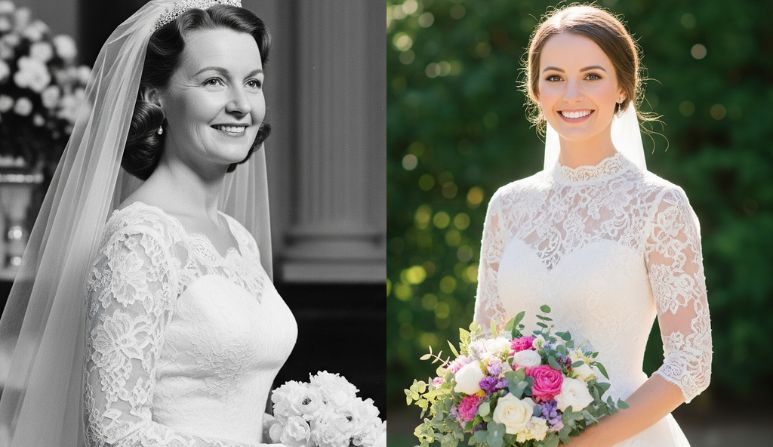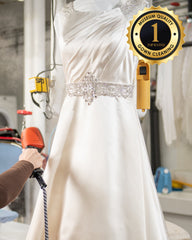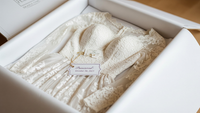The first time you hold your grandmother’s wedding dress is breathtaking.
The laughter in old photographs.
The vows spoken decades ago.
The family stories you’ve heard since childhood.
But with all that history comes the worry: can something so fragile, so old, really be worn again?
The honest answer is yes—often it can. With the right care, a gown yellowed by time can be gently whitened, lace reinforced, and seams strengthened for a secure, comfortable fit.
For many brides, it isn’t just about wearing a dress. It’s about carrying her legacy down the aisle—and yes, that is possible.
What You’ll Learn in This Blog
-
Whether it’s truly possible to wear your grandmother’s wedding dress again
-
The step-by-step restoration journey: assessment, cleaning, alterations, updates, and storage
-
The timeline and typical costs of restoring an heirloom wedding gown
-
Safe ways to reverse yellowing and strengthen fragile fabrics without DIY risks
-
How seamstresses can resize or update the gown for comfort while preserving its essence
-
Creative ideas for repurposing a gown that can’t be worn into veils, accessories, or keepsakes
-
Real-life examples of brides who walked down the aisle in their grandmother’s gown
Quick Answer & 5-Step Plan
You’ll probably notice it right away—the lace that’s softened with age, the ivory that’s now more buttercream than white, maybe even a seam that feels a little fragile under your fingertips.
That’s why the very next step after holding it in your hands isn’t to panic—it’s to let trained eyes look it over. Here’s the journey, step by step:
| Step | What Happens |
|---|---|
| 1. Assessment of the wedding dress | A preservation cleaner and vintage-savvy seamstress checks fabric strength, seams, and closures. |
| 2. Cleaning & Restoration | Museum-grade cleaning carefully lifts yellowing and oxidation without harsh chemicals, and restores the dress to its original glory. |
| 3. Alterations | Seams are reinforced, boning secured, and the fit tailored. |
| 4. Comfort Updates | Add a lining, cups, bustle, or replace fragile zippers/buttons with period-appropriate details. |
| 5. Storage | The gown is packed in an acid-free box with acid-neutral tissue, kept in a cool, dark space. |
Here are the most popular questions people also ask:
-
Can a 50-year-old dress be restored?
Often, yes, as long as the fabric is still intact, wedding dress restoration kits can repair delicate, aged gown areas and give the gown new life.
-
Can dry cleaners remove yellowing?
Standard dry cleaning usually can’t fix oxidation; this is where museum-grade cleaning and preservation experts step in—they know how to gently lift those years without harming the fabric.
Check out the before and after restoration photos of this bride on Reddit who wore her grandma’s 1953 wedding dress to her own wedding!

Timeline & Typical Costs
Here is everything that you can expect on this journey where you honor the history your grandmother’s dress carries while preparing it for your special day.
-
Weeks 0–2 – Assess & Plan: Check and make notes of the current situation of the dress. Document everything from fabric strength to the seams, and plan what kind of services you will require for the dress.
-
Weeks 2–8 – Cleaning & Restoration: Arrange for the gown to be sent to preservation experts and have it properly cleaned and restored to lift yellowing, oxidation, and other necessary repairs.
-
Weeks 6–12+ – Alterations & Comfort: Attend fitting with a seamstress. Discuss everything that is required to make the gown comfortable and personalized for you while keeping the originality intact.
-
Weeks 12–16 – Final Touches & Storage: Check the gown one last time before placing it back inside the preservation chest, padded with acid-neutral tissue until your wedding day
Costs to keep in mind
Different aspects of the wedding dress, like fabric age and details like lace or beading, result in variation in restoration and alteration costs. However,it typically ranges from anywhere between $300 to $800+.
A Real-Life Example

Wearing your grandmother’s wedding dress isn’t just a dream—it’s possible. Business Insider shared the story of multiple brides who wore their grandmother’s wedding gowns on their wedding day. In some cases, the very same dress had also been worn by the bride’s mother at their wedding. Three generations, one gown, and decades later, it still carried the family’s love down the aisle.
These stories prove what experts already know: with the right preservation and a few thoughtful updates, heirloom dresses can live on—ready to create new memories while honoring old ones.
If you’re considering reviving a vintage gown, professional restoration and preservation can help your dress stand beautifully for its next walk down the aisle.
Questions Brides Also Commonly Ask
What can be done with Grandma’s wedding dress if it can’t be worn?
You can repurpose the fabric into a veil, cape, bouquet wrap, ring pillow, or even a christening gown for the next generation!
Can a yellowed wedding dress be restored or whitened?
Yes. Preservation and restoration processes can safely reverse yellowing and brighten the gown without harsh bleaches that would damage the fibers.
How to restore old wedding dresses safely?
Skip DIY fixes like bleach or spot treatments. The safest way is through professional wedding dress preservationists who use gentle, fabric-specific techniques.
What if the dress is several sizes different?
Skilled seamstresses can resize, add panels, or redesign sections to make the gown fit beautifully while keeping its original essence intact.












 200 Business Park, Freehold, NJ 07728
200 Business Park, Freehold, NJ 07728
 (866) 308-8822
(866) 308-8822 info@trustedweddinggownpreservation.com
info@trustedweddinggownpreservation.com
